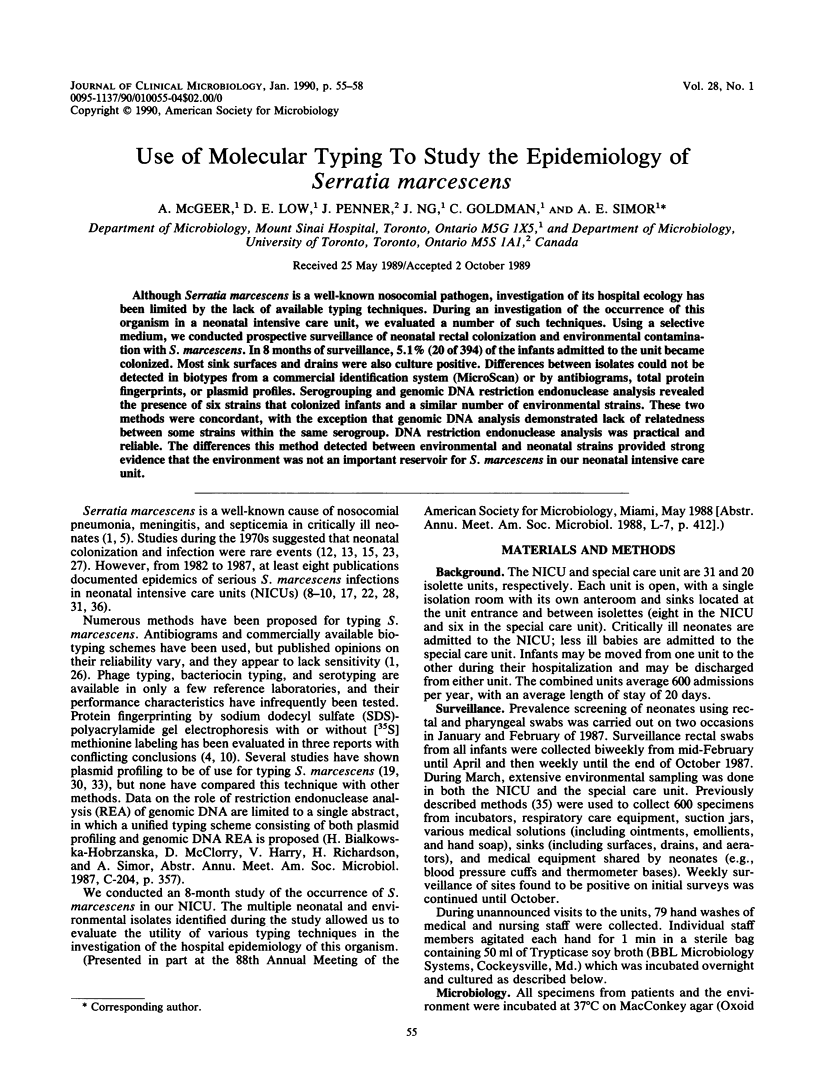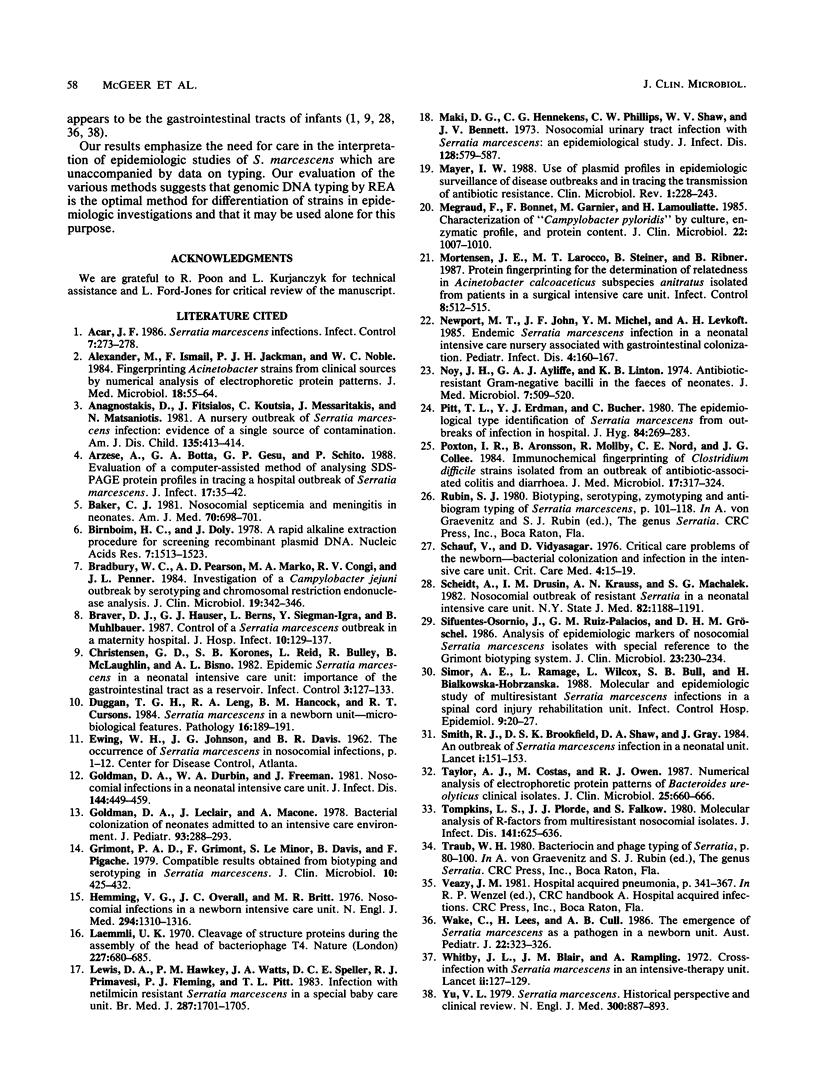Abstract
Although Serratia marcescens is a well-known nosocomial pathogen, investigation of its hospital ecology has been limited by the lack of available typing techniques. During an investigation of the occurrence of this organism in a neonatal intensive care unit, we evaluated a number of such techniques. Using a selective medium, we conducted prospective surveillance of neonatal rectal colonization and environmental contamination with S. marcescens. In 8 months of surveillance, 5.1% (20 of 394) of the infants admitted to the unit became colonized. Most sink surfaces and drains were also culture positive. Differences between isolates could not be detected in biotypes from a commercial identification system (MicroScan) or by antibiograms, total protein fingerprints, or plasmid profiles. Serogrouping and genomic DNA restriction endonuclease analysis revealed the presence of six strains that colonized infants and a similar number of environmental strains. These two methods were concordant, with the exception that genomic DNA analysis demonstrated lack of relatedness between some strains within the same serogroup. DNA restriction endonuclease analysis was practical and reliable. The differences this method detected between environmental and neonatal strains provided strong evidence that the environment was not an important reservoir for S. marcescens in our neonatal intensive care unit.
Full text
PDF



Images in this article
Selected References
These references are in PubMed. This may not be the complete list of references from this article.
- Acar J. F. Serratia marcescens infections. Infect Control. 1986 May;7(5):273–278. doi: 10.1017/s0195941700064201. [DOI] [PubMed] [Google Scholar]
- Alexander M., Ismail F., Jackman P. J., Noble W. C. Fingerprinting Acinetobacter strains from clinical sources by numerical analysis of electrophoretic protein patterns. J Med Microbiol. 1984 Aug;18(1):55–64. doi: 10.1099/00222615-18-1-55. [DOI] [PubMed] [Google Scholar]
- Anagnostakis D., Fitsialos J., Koutsia C., Messaritakis J., Matsaniotis N. A nursery outbreak of Serratia marcescens infection. Evidence of a single source of contamination. Am J Dis Child. 1981 May;135(5):413–414. doi: 10.1001/archpedi.1981.02130290011005. [DOI] [PubMed] [Google Scholar]
- Arzese A., Botta G. A., Gesu G. P., Schito G. Evaluation of a computer-assisted method of analysing SDS-PAGE protein profiles in tracing a hospital outbreak of Serratia marcescens. J Infect. 1988 Jul;17(1):35–42. doi: 10.1016/s0163-4453(88)92284-0. [DOI] [PubMed] [Google Scholar]
- Baker C. J. Nosocomial septicemia and meningitis in neonates. Am J Med. 1981 Mar;70(3):698–701. doi: 10.1016/0002-9343(81)90599-4. [DOI] [PubMed] [Google Scholar]
- Birnboim H. C., Doly J. A rapid alkaline extraction procedure for screening recombinant plasmid DNA. Nucleic Acids Res. 1979 Nov 24;7(6):1513–1523. doi: 10.1093/nar/7.6.1513. [DOI] [PMC free article] [PubMed] [Google Scholar]
- Bradbury W. C., Pearson A. D., Marko M. A., Congi R. V., Penner J. L. Investigation of a Campylobacter jejuni outbreak by serotyping and chromosomal restriction endonuclease analysis. J Clin Microbiol. 1984 Mar;19(3):342–346. doi: 10.1128/jcm.19.3.342-346.1984. [DOI] [PMC free article] [PubMed] [Google Scholar]
- Braver D. J., Hauser G. J., Berns L., Siegman-Igra Y., Muhlbauer B. Control of a Serratia marcescens outbreak in a maternity hospital. J Hosp Infect. 1987 Sep;10(2):129–137. doi: 10.1016/0195-6701(87)90138-1. [DOI] [PubMed] [Google Scholar]
- Christensen G. D., Korones S. B., Reed L., Bulley R., McLaughlin B., Bisno A. L. Epidemic Serratia marcescens in a neonatal intensive care unit: importance of the gastrointestinal tract as a reservoir. Infect Control. 1982 Mar-Apr;3(2):127–133. doi: 10.1017/s0195941700055909. [DOI] [PubMed] [Google Scholar]
- Duggan T. G., Leng R. A., Hancock B. M., Cursons R. T. Serratia marcescens in a newborn unit--microbiological features. Pathology. 1984 Apr;16(2):189–191. doi: 10.3109/00313028409059103. [DOI] [PubMed] [Google Scholar]
- Goldmann D. A., Durbin W. A., Jr, Freeman J. Nosocomial infections in a neonatal intensive care unit. J Infect Dis. 1981 Nov;144(5):449–459. doi: 10.1093/infdis/144.5.449. [DOI] [PubMed] [Google Scholar]
- Goldmann D. A., Leclair J., Macone A. Bacterial colonization of neonates admitted to an intensive care environment. J Pediatr. 1978 Aug;93(2):288–293. doi: 10.1016/s0022-3476(78)80523-x. [DOI] [PubMed] [Google Scholar]
- Grimont P. A., Grimont F., Le Minor S., Davis B., Pigache F. Compatible results obtained from biotyping and serotyping in Serratia marcescens. J Clin Microbiol. 1979 Oct;10(4):425–432. doi: 10.1128/jcm.10.4.425-432.1979. [DOI] [PMC free article] [PubMed] [Google Scholar]
- Hemming V. G., Overall J. C., Jr, Britt M. R. Nosocomial infections in a newborn intensive-care unit. Results of forty-one months of surveillance. N Engl J Med. 1976 Jun 10;294(24):1310–1316. doi: 10.1056/NEJM197606102942403. [DOI] [PubMed] [Google Scholar]
- Laemmli U. K. Cleavage of structural proteins during the assembly of the head of bacteriophage T4. Nature. 1970 Aug 15;227(5259):680–685. doi: 10.1038/227680a0. [DOI] [PubMed] [Google Scholar]
- Lewis D. A., Hawkey P. M., WattsJA, Speller D. C., Primavesi R. J., Fleming P. J., Pitt T. L. Infection with netilmicin resistant Serratia marcescens in a special care baby unit. Br Med J (Clin Res Ed) 1983 Dec 3;287(6406):1701–1705. doi: 10.1136/bmj.287.6406.1701. [DOI] [PMC free article] [PubMed] [Google Scholar]
- Maki D. G., Hennekens C. G., Phillips C. W., Shaw W. V., Bennett J. V. Nosocomial urinary tract infection with Serratia marcescens: an epidemiologic study. J Infect Dis. 1973 Nov;128(5):579–587. doi: 10.1093/infdis/128.5.579. [DOI] [PubMed] [Google Scholar]
- Mayer L. W. Use of plasmid profiles in epidemiologic surveillance of disease outbreaks and in tracing the transmission of antibiotic resistance. Clin Microbiol Rev. 1988 Apr;1(2):228–243. doi: 10.1128/cmr.1.2.228. [DOI] [PMC free article] [PubMed] [Google Scholar]
- Megraud F., Bonnet F., Garnier M., Lamouliatte H. Characterization of "Campylobacter pyloridis" by culture, enzymatic profile, and protein content. J Clin Microbiol. 1985 Dec;22(6):1007–1010. doi: 10.1128/jcm.22.6.1007-1010.1985. [DOI] [PMC free article] [PubMed] [Google Scholar]
- Mortensen J. E., LaRocco M. T., Steiner B., Ribner B. Protein fingerprinting for the determination of relatedness in Acinetobacter calcoaceticus subspecies anitratus isolated from patients in a surgical intensive care unit. Infect Control. 1987 Dec;8(12):512–515. doi: 10.1017/s0195941700067588. [DOI] [PubMed] [Google Scholar]
- Newport M. T., John J. F., Michel Y. M., Levkoff A. H. Endemic Serratia marcescens infection in a neonatal intensive care nursery associated with gastrointestinal colonization. Pediatr Infect Dis. 1985 Mar-Apr;4(2):160–167. doi: 10.1097/00006454-198503000-00010. [DOI] [PubMed] [Google Scholar]
- Noy J. H., Ayliffe G. A., Linton K. B. Antibiotic-resistant gram-negative bacilli in the faeces of neonates. J Med Microbiol. 1974 Nov;7(4):509–520. doi: 10.1099/00222615-7-4-509. [DOI] [PubMed] [Google Scholar]
- Pitt T. L., Erdman Y. J., Bucher C. The epidemiological type identification of Serratia marcescens from outbreaks of infection in hospitals. J Hyg (Lond) 1980 Apr;84(2):269–283. doi: 10.1017/s0022172400026772. [DOI] [PMC free article] [PubMed] [Google Scholar]
- Poxton I. R., Aronsson B., Möllby R., Nord C. E., Collee J. G. Immunochemical fingerprinting of Clostridium difficile strains isolated from an outbreak of antibiotic-associated colitis and diarrhoea. J Med Microbiol. 1984 Jun;17(3):317–324. doi: 10.1099/00222615-17-3-317. [DOI] [PubMed] [Google Scholar]
- Schauf V., Vidyasagar D. Critical care problems of the newborn. Bacterial colonization and infection in the intensive care unit. Crit Care Med. 1976 Jan-Feb;4(1):15–19. doi: 10.1097/00003246-197601000-00004. [DOI] [PubMed] [Google Scholar]
- Scheidt A., Drusin L. M., Krauss A. N., Machalek S. G. Nosocomial outbreak of resistant Serratia in a neonatal intensive care unit. N Y State J Med. 1982 Jul;82(8):1188–1191. [PubMed] [Google Scholar]
- Sifuentes-Osornio J., Ruiz-Palacios G. M., Gröschel D. H. Analysis of epidemiologic markers of nosocomial Serratia marcescens isolates with special reference to the Grimont biotyping system. J Clin Microbiol. 1986 Feb;23(2):230–234. doi: 10.1128/jcm.23.2.230-234.1986. [DOI] [PMC free article] [PubMed] [Google Scholar]
- Simor A. E., Ramage L., Wilcox L., Bull S. B., Bialkowska-Hobrzanska H. Molecular and epidemiologic study of multiresistant Serratia marcescens infections in a spinal cord injury rehabilitation unit. Infect Control. 1988 Jan;9(1):20–27. [PubMed] [Google Scholar]
- Smith P. J., Brookfield D. S., Shaw D. A., Gray J. An outbreak of Serratia marcescens infections in a neonatal unit. Lancet. 1984 Jan 21;1(8369):151–153. doi: 10.1016/s0140-6736(84)90074-6. [DOI] [PubMed] [Google Scholar]
- Taylor A. J., Costas M., Owen R. J. Numerical analysis of electrophoretic protein patterns of Bacteroides ureolyticus clinical isolates. J Clin Microbiol. 1987 Apr;25(4):660–666. doi: 10.1128/jcm.25.4.660-666.1987. [DOI] [PMC free article] [PubMed] [Google Scholar]
- Tompkins L. S., Plorde J. J., Falkow S. Molecular analysis of R-factors from multiresistant nosocomial isolates. J Infect Dis. 1980 May;141(5):625–636. doi: 10.1093/infdis/141.5.625. [DOI] [PubMed] [Google Scholar]
- Wake C., Lees H., Cull A. B. The emergence of Serratia marcescens as a pathogen in a newborn unit. Aust Paediatr J. 1986 Nov;22(4):323–326. doi: 10.1111/j.1440-1754.1986.tb02158.x. [DOI] [PubMed] [Google Scholar]
- Whitby J. L., Blair J. N., Rampling A. Cross-infection with Serratia marcescens in an intensive-therapy unit. Lancet. 1972 Jul 15;2(7768):127–129. doi: 10.1016/s0140-6736(72)91612-1. [DOI] [PubMed] [Google Scholar]
- Yu V. L. Serratia marcescens: historical perspective and clinical review. N Engl J Med. 1979 Apr 19;300(16):887–893. doi: 10.1056/NEJM197904193001604. [DOI] [PubMed] [Google Scholar]




